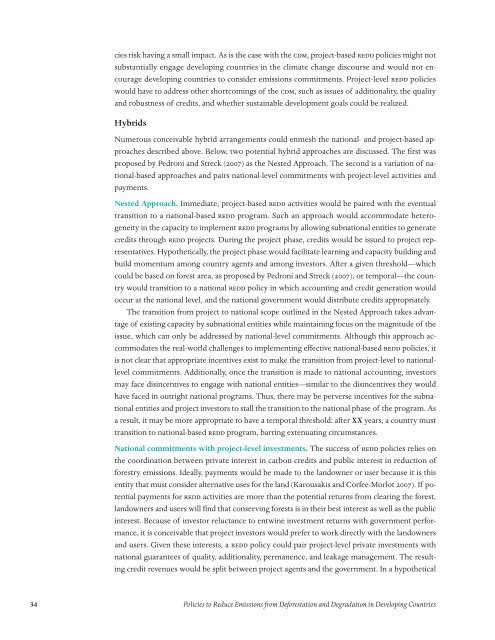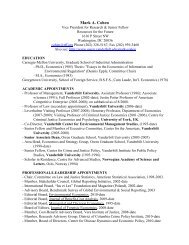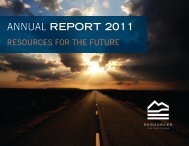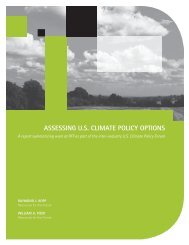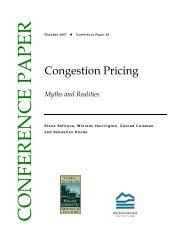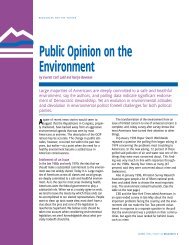Policies to Reduce Emissions from Deforestation and Degradation ...
Policies to Reduce Emissions from Deforestation and Degradation ...
Policies to Reduce Emissions from Deforestation and Degradation ...
You also want an ePaper? Increase the reach of your titles
YUMPU automatically turns print PDFs into web optimized ePapers that Google loves.
cies risk having a small impact. As is the case with the CDM, project-based REDD policies might not<br />
substantially engage developing countries in the climate change discourse <strong>and</strong> would not encourage<br />
developing countries <strong>to</strong> consider emissions commitments. Project-level REDD policies<br />
would have <strong>to</strong> address other shortcomings of the CDM, such as issues of additionality, the quality<br />
<strong>and</strong> robustness of credits, <strong>and</strong> whether sustainable development goals could be realized.<br />
Hybrids<br />
Numerous conceivable hybrid arrangements could enmesh the national- <strong>and</strong> project-based approaches<br />
described above. Below, two potential hybrid approaches are discussed. The first was<br />
proposed by Pedroni <strong>and</strong> Streck (2007) as the Nested Approach. The second is a variation of national-based<br />
approaches <strong>and</strong> pairs national-level commitments with project-level activities <strong>and</strong><br />
payments.<br />
Nested Approach. Immediate, project-based REDD activities would be paired with the eventual<br />
transition <strong>to</strong> a national-based REDD program. Such an approach would accommodate heterogeneity<br />
in the capacity <strong>to</strong> implement REDD programs by allowing subnational entities <strong>to</strong> generate<br />
credits through REDD projects. During the project phase, credits would be issued <strong>to</strong> project representatives.<br />
Hypothetically, the project phase would facilitate learning <strong>and</strong> capacity building <strong>and</strong><br />
build momentum among country agents <strong>and</strong> among inves<strong>to</strong>rs. After a given threshold—which<br />
could be based on forest area, as proposed by Pedroni <strong>and</strong> Streck (2007), or temporal—the country<br />
would transition <strong>to</strong> a national REDD policy in which accounting <strong>and</strong> credit generation would<br />
occur at the national level, <strong>and</strong> the national government would distribute credits appropriately.<br />
The transition <strong>from</strong> project <strong>to</strong> national scope outlined in the Nested Approach takes advantage<br />
of existing capacity by subnational entities while maintaining focus on the magnitude of the<br />
issue, which can only be addressed by national-level commitments. Although this approach accommodates<br />
the real-world challenges <strong>to</strong> implementing effective national-based REDD policies, it<br />
is not clear that appropriate incentives exist <strong>to</strong> make the transition <strong>from</strong> project-level <strong>to</strong> nationallevel<br />
commitments. Additionally, once the transition is made <strong>to</strong> national accounting, inves<strong>to</strong>rs<br />
may face disincentives <strong>to</strong> engage with national entities—similar <strong>to</strong> the disincentives they would<br />
have faced in outright national programs. Thus, there may be perverse incentives for the subnational<br />
entities <strong>and</strong> project inves<strong>to</strong>rs <strong>to</strong> stall the transition <strong>to</strong> the national phase of the program. As<br />
a result, it may be more appropriate <strong>to</strong> have a temporal threshold: after XX years, a country must<br />
transition <strong>to</strong> national-based REDD program, barring extenuating circumstances.<br />
National commitments with project-level investments. The success of REDD policies relies on<br />
the coordination between private interest in carbon credits <strong>and</strong> public interest in reduction of<br />
forestry emissions. Ideally, payments would be made <strong>to</strong> the l<strong>and</strong>owner or user because it is this<br />
entity that must consider alternative uses for the l<strong>and</strong> (Karousakis <strong>and</strong> Corfee-Morlot 2007). If potential<br />
payments for REDD activities are more than the potential returns <strong>from</strong> clearing the forest,<br />
l<strong>and</strong>owners <strong>and</strong> users will find that conserving forests is in their best interest as well as the public<br />
interest. Because of inves<strong>to</strong>r reluctance <strong>to</strong> entwine investment returns with government performance,<br />
it is conceivable that project inves<strong>to</strong>rs would prefer <strong>to</strong> work directly with the l<strong>and</strong>owners<br />
<strong>and</strong> users. Given these interests, a REDD policy could pair project-level private investments with<br />
national guarantees of quality, additionality, permanence, <strong>and</strong> leakage management. The resulting<br />
credit revenues would be split between project agents <strong>and</strong> the government. In a hypothetical<br />
34 <strong>Policies</strong> <strong>to</strong> <strong>Reduce</strong> <strong>Emissions</strong> <strong>from</strong> <strong>Deforestation</strong> <strong>and</strong> <strong>Degradation</strong> in Developing Countries


